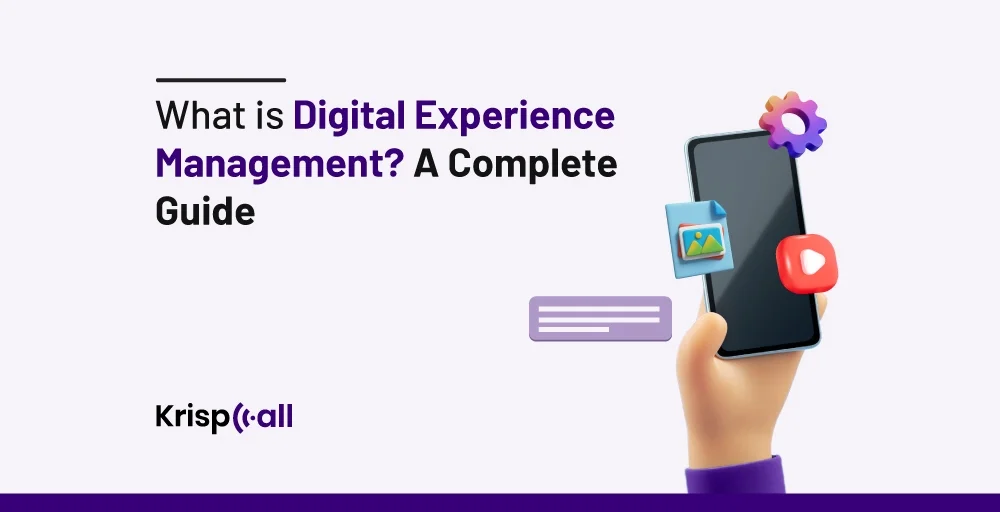To avoid bad customer experiences for any business, providing the highest quality digital customer experience has to be a priority. Statistically speaking, it’s true since a report by PWC says that 32% of customers walk away from a brand they love after a single bad experience.
So, how do we deal with that? Don’t worry; we’ve got a solution for it! 😀
The increasingly popular concept of Digital Experience Management (DXM) 🎉is the solution, and it can help your companies connect with customers on the digital front.
So, with this blog, we will discuss what it is, how it benefits a contact center, and how it enables business transformation. So what’s the wait? Let’s begin.
🔑 KEY HIGHLIGHTS
- Digital experience management involves managing people’s interactions with digital platforms, services, and content through various channels.
- Digital experience management offers businesses the advantages of enhanced customer engagement, personalized experience, streamlined operations, brand consistency, and actionable insights for informed decision-making.
- Key components of DXM are web analytics, tracking customer interactions, personalization through technology, user experience designing, and integration of multiple communication channels into one.
- Digital Experience Manager oversees and enhances online interactions, optimizing user journeys, content delivery, and engagement across digital platforms.
What Is Digital Experience Management?
Digital experience strategy is a systematic framework that organizations develop to deliver exceptional digital experiences to their target audience. Simply put, this means that DXM involves managing people’s interactions with digital platforms, services, and content through various channels and devices, such as mobile applications, company websites, and social media touchpoints.
Furthermore, it encompasses a range of elements, including user experience (UX) design, content strategy, technology infrastructure, performance optimization, and analytics.
But at first glance, DXM might appear to be among the trendy terms, such as User Experience (UX) and Customer Experience (CX). However, with its unique solution, your business can effectively manage its consumers’ omnichannel, real-time experiences. This means that if your customers’ demand for faster and smoother experiences grows, DXM will help make the digital journey more enjoyable.
Hence, DXM not only provides the platform and tools needed for company executives, administrators in IT, developers, and service providers but also helps them understand how well their digital transformation is working.
Here’s a fun fact about the global digital experience platform market. It is forecasted to expand at a CAGR of 8.3% and thereby increase from a value of US$9.2 Bn in 2023 to US$19.3 Bn by the end of 2030 – according to a report by Persistence Market Research.
Moreover, DXM goes far beyond simply collecting technical gauges such as CPU and memory utilization. It also includes analyzing the actual user experience- how apps seem and operate on different platforms like smartphones, tablets, and desktop computers.
Digital Experience vs. Customer Experience. What is The Difference?
For DXM to play a key role in creating exceptional digital interactions, it is equally important to understand the differences between digital experience (DX) and customer experience (CX). These two terms are closely related. Yet, they encompass distinct perspectives and focuses.
Digital experience is the overall experience that users have when interacting with digital products. Not to mention, it encompasses all the aspects of the customer journey. This includes design, performance, functionality, and satisfaction with the digital interface. Furthermore, it primarily focuses on the technical and functional aspects of digital interaction.
Hence, emphasizes how well the technology enables users to achieve their goals efficiently and effectively. Meanwhile, digital experiences focus specifically on customers’ online and in-person interactions, customer service interactions, and product use.
Meanwhile, CX mainly emphasizes the holistic perception and emotional response of customers to their overall experience with a brand, product, or service. Its main focus is to build long-term relationships and customer loyalty.
Furthermore, Customer Experience (CX) encompasses both digital and physical touchpoints, encompassing how customers interact with and perceive brands. It includes both digital and non-digital interactions, such as in-person interactions, customer service interactions, marketing communications, product quality, brand perception, and post-purchase support.
Key Components of Digital Experience Management
With the perfect delivery of practical digital experience, businesses can create much more for their entire workforce. If organizations use it, they need to manage it.
Therefore, it is crucial to know a bit about the components of digital experience management to optimize and increase customer satisfaction. So, to manage digital experiences effectively, the following components are essential:
- Web analytics: It involves tracking and analyzing user behavior on your websites and understanding how users find and navigate your site.
- Tracking customer interactions: This involves monitoring how users interact with your product or services. This can include tracking website clicks, app usage, customer support interactions, and more.
- Technology to personalize: This tool allows the tailoring of the experience for individual users based on their data. It includes customizing website content, product recommendations, or marketing messages for a more relevant and engaging experience.
- Integration of multiple channels: It is the combination of data from various channels like websites, social media, and email marketing, to get a holistic view of your customer journey. This allows you to understand how users interact with your brand across different touchpoints.
- User Experience Design(UI/UX): This focuses on designing user interfaces (UI) that are easy to use and navigate, and crafting user experiences (UX) that are positive and engaging.
It is to be noted that by knowing about these elements and properly using each across various digital platforms and touchpoints, seamless and optimized user experiences are delivered.
Benefits of Digital Experience Management
When used correctly, DXM can offer your business many benefits. When you embrace DXM, you gain many opportunities that can transform your customer experience and help your business succeed. So, what are the exact benefits of the digital experience that you can get?
Here are some key points that illustrate this:
1. Personalized experiences
Your customers’ preferences, behaviors, and needs should be taken into account if you ever want to deliver tailored experiences. The easy thing is that with the data and insights you gain from DXM practices, you can build personalized customer journeys that will engage your customers at every point of contact, ensuring their satisfaction and loyalty.
2. Coverage of all touchpoints
Also, if you want to provide consistent and cohesive experiences across all digital touchpoints, including websites, mobile apps, social media platforms, and other channels, using DXM comes with great benefits. In fact, when your brand interacts with customers across multiple platforms, DXM gives you comprehensive coverage that enhances engagement and reduces friction.
3. Brand consistency
If you want to maintain brand consistency, DXM has considerable benefits in this case as well. It can ensure that all of your digital channels are consistent with your branding, messaging, and visual elements. This improves the ability of your customers to remember your brand, reinforces trust, and builds loyalty in their minds.
4. Get data-driven insights
With DXM, you also get data and analytics regarding customer behavior, preferences, and trends that you can use to gain deeper insights and leverage those. These insights can help you make informed decisions, optimize your digital experiences, and refine your strategies to more effectively meet your customers’ needs.
5. Better automate tools and services
DXM practices also involve integrations with various automating tools and services. You can use all of those perfectly to enhance operational efficiency and streamline workflows. This serves as a benefit as your teams can work more collaboratively, reduce manual work, and get stuff done faster.
6. Market Penetration Is Faster
DXM practices also come along with agile development and deployment of digital experiences, new products, features, and campaigns can be launched faster. What it means is that with it as an added benefit, it becomes easier to adapt to changing market dynamics and stay ahead of the competition when your processes are streamlined.
What Does a Digital Experience Manager Do?
A digital experience manager has many roles to play in an organization. They mostly oversee the development, implementation, and optimization of digital strategies to enhance user experiences and drive business growth. But here are more:
Data analysis
Still, doubting the power of data-driven decision-making? You can start data analysis for it. As a common thing many digital experience managers develop the strongest analytical abilities to be seen in performance analysis.
Not to mention, they thoroughly explore metrics and analytics, uncovering insights to further improve and optimize the digital experience utilizing analytics tools. As a manager, they typically collect information about user behaviors, page views, bounce rate, conversion rate, and other metrics that relate to engagement.
So, after gathering this data, they generally identify the market dynamics or trends and make significant improvements to your digital experience.
Content and design oversight
Having appealing and gripping content is one of the cornerstone aspects of the digital experience. As for digital experience managers, they do it to supervise the production, administration, and distribution of content across various digital platforms. In addition, the manager ensures that the quality of the content is in line with their brand personality and ultimate message.
Moreover, to meet business and customer expectations, managers also work with the designers to make certain their designs are aligned with the overall UX strategy.
Integrated technology
It’s not surprising that technology generates digital experiences. Similarly, for digital experience managers, these are chances to enhance customer interactions at every touchpoint. They do it as a matter of course by using a mix of several integrated technologies such as CRM software, data analytics tools, and content management systems (CMS).
Managers set up these tools with the IT and development teams so that they guarantee seamless workforce productivity and user interactions.
How to Upgrade Your Contact Center Through Digital Experience Management?
By seamlessly upgrading your contact center through digital experience management is one of the important things to do. But don’t know what to do? Then, let’s see the overview.
1. Understand Your Audience
Understand your target audience thoroughly. This includes exploring various digital touchpoints to identify their preferences, behaviors, and pain points. Using this knowledge, we can tailor digital experiences that are relevant and tailored to the user.
2. Create a Seamless Omnichannel Experience
Keeping up with social media is just one part of what modern businesses do. Aside from emails, website pages, checkouts, product listings, and advertisements, they also manage emails and website pages. So, to make all these things work in harmony, it is essential to create a seamless unified omnichannel experience.
3. Implement Personalization Strategies
Personalization is one of the most essential things to upgrade your contact center’s service delivery. Also, personalized experiences are delivered by leveraging the power of data. So, what needs to be done here is to provide content that is relevant and offerings that are communication-based on the preferences and histories of each customer.
4. Continuous Data Analysis
If you wish to upgrade your contact center’s ability through digital experience management, you need to analyze customer interaction data with the aid of data analytics tools. Here you need to find out what the trends are, where the pain points are, and what needs to be improved. Using this data, improve your digital experience and customer satisfaction continuously.
5. Implement Feedback Mechanisms
The best way to stay ahead is to actively listen to your employees and customers and value their feedback. So, it’s a good idea to gather customer insights directly through your digital channels by implementing best practices for Customer Feedback Management (CFM). With these insights, you will be able to make precise enhancements based on their needs, issues, and expectations.
6. Measure and Refine
The last to do is quantify the success of your DEM initiatives by establishing key performance indicators (KPIs). It is an easy thing to accomplish, and for it all you need to do is keep a close eye on metrics such as CSAT, call resolution times, and customer self-service usage rates. Based on these metrics, constantly refine your strategies.
Final Thoughts
With a better understanding of how digital experience management works and how it can be used, you (as a manager) can manage, optimize, and track all aspects of customers’ digital experiences and how they interact.
Also, by knowing what DEM is and how it can benefit your business, get ready to manage your digital experiences and bring your customer experience to the next level. Additionally, to say more, it improves sales, profits, and ROI and ensures brand consistency. That is if you choose the right platform for your digital experience management needs.
FAQs
Why is digital experience management important?
Digital experience management (DEM) is essential since it focuses on maximizing consumer contact with digital assets, platforms, and channels. Furthermore, it ensures that your business can meet customer expectations seamlessly.
What is digital experience strategy?
Digital experience strategy is a systematic framework that organizations develop to deliver exceptional digital experiences to their target audience. However, it encompasses a range of elements, including user experience (UX) design, content strategy, technology infrastructure, performance optimization, and analytics.





